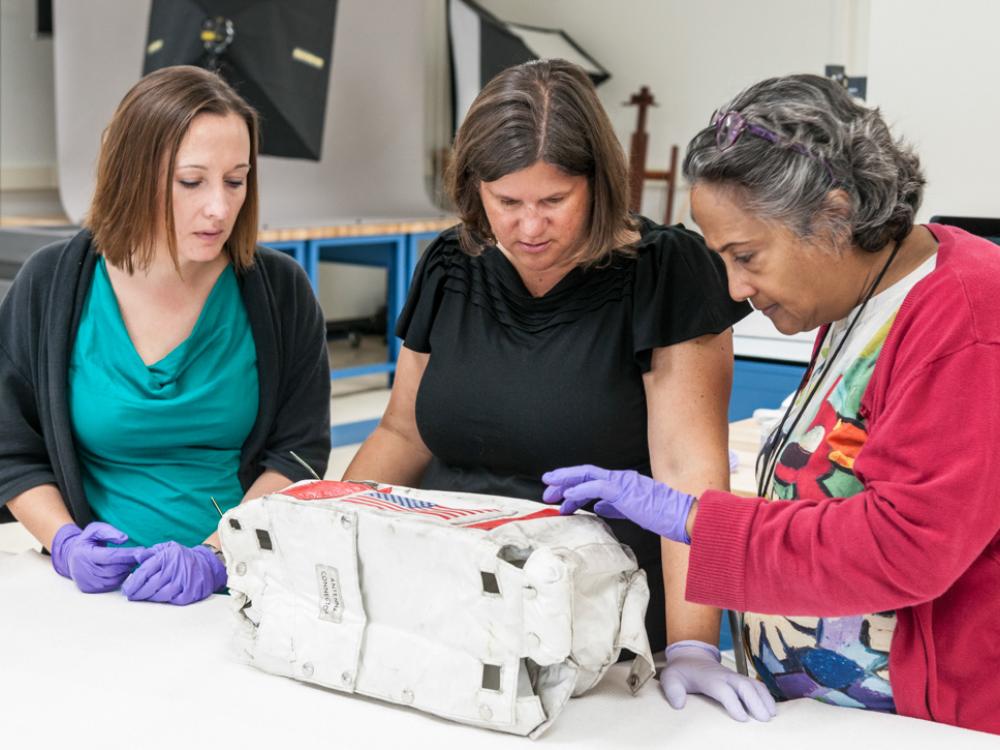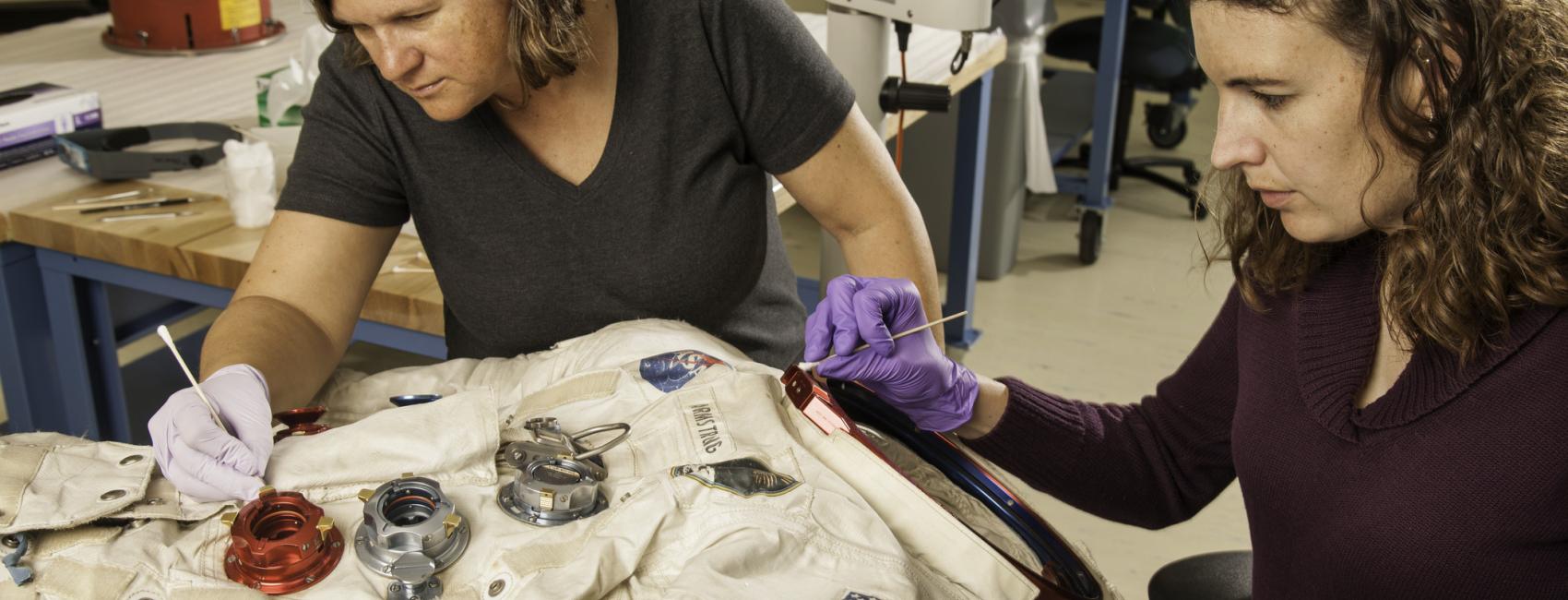
Jan 20, 2015
By Lisa Young, Objects Conservator, National Air and Space Museum
It was particularly timely that during the hustle and bustle of the 2014 holidays, I, along with curators Jennifer Levasseur and Cathleen Lewis, had a very special package to open for the very first time. We had astronaut Captain Gene Cernan and NASA to thank for the gift. Following his Apollo 17 mission, Capt. Cernan returned his Oxygen Purge System (OPS) cover to Earth in December 1972—an object that once covered his personal life support system (PLSS). The cover was examined by NASA and then sealed in plastic. This object, like most other flown hardware, was inspected post-flight, inventoried, and put on a storage shelf where it became a part of NASA’s flight collection. The National Air and Space Museum received the cover—still sealed in its plastic wrap — in the 1980s along with other Apollo-era artifacts which found a home for nearly three decades at the Museum’s Paul E. Garber Restoration and Storage Facility. During a recent survey of the collection, the object was rediscovered in storage where it laid untouched and sealed just as it was when it was returned from the lunar surface.
The Museum received this Oxygen Purge System cover used by Gene Cernan during Apollo 17 in the 1980s. The artifact came sealed in a plastic bag. In 2014, Museum curators and conservators opened the package for the very first time.
To commemorate the 50th anniversary of the first American spacewalk by Gemini IV astronaut Edward White in 1965, the Museum recently opened a new exhibition, Outside the Spacecraft: 50 Years of Extra-Vehicular Activity, which highlights art, photography, artifacts, and personal accounts that represent Extra-Vehicular Activity (EVA) from Gemini, Apollo, Skylab, and Shuttle missions. Capt. Gene Cernan performed one near-fatal EVA during his Gemini IX-A mission and three moonwalks during Apollo 17 with astronaut-geologist Harrison “Jack” Schmitt. He was also the last man to walk on the Moon.
Capt. Cernan’s OPS cover was chosen for display to highlight this moonwalk and to represent part of his life support system. In order to exhibit the OPS cover, the plastic wrap would have to be opened for the first time since it was sealed in 1973. The conservation team agreed to open the object in a controlled environment in the Emil Buehler Conservation Laboratory at the Steven F. Udvar-Hazy Center in Chantilly, Virginia. The event was documented by photo and video as none of us really knew what we would find. This allowed the conservation work to be archived so that I could keep working uninterrupted and focus on this important object as each side of the cover was carefully unfolded.
Curators Jennifer Levasseur and Cathleen Lewis, along with conservator Lisa Young, examine the oxygen purge system cover used by Gene Cernan during Apollo 17. The cover had been sealed in plastic by NASA for nearly three decades.
The most surprising thing about opening the object was the lack of loose lunar dust. The surfaces appear gray when you look at them and lunar particles are seen embedded in the fibers of the outer fabric. However, the lack of excess dust in the creases and folds of the cover indicated to me that the object may have been cleaned before it was packaged in 1973. As we examined the object more closely, carefully rearranging the fragile fabric, the cover slowly returned to its original shape. The condition of the preserved object was remarkable considering that many materials from this period are inherently unstable. The outermost fabric of the cover is made of a tightly woven fiberglass material called Beta cloth. Inside the cover are additional layers of space-age fabrics such as Mylar, Dacron, Nylon, and Kapton. All of these materials can become brittle with age and often show signs of instability due to their exposure to the harsh environment of space. Physical damage to the object from use was also noticeable when we looked at the object. It was definitely used, and the evidence of Cernan’s activity on the lunar surface was marked by wear seen on the materials in the form of abrasions, tears, and minor loss. While this type of damage from operational use is not uncommon, what was surprising were the repairs made to the outer fabric someone performed in order to mend the cover.
Upon further examination, a white opaque silicone coating was seen applied to the exterior of the fabric over these small tears. This was most likely applied to the fabric to keep the fibers from fraying any further. In one spot, several hand-stitched threads (dark grey in color) were also discovered to hold a small tear together. It is not clear when the repairs were made or by whom, but careful examination indicated initially that the repairs were most likely made after the flight. The painted United States flag applied to the back of the cover also shows some minor abrasions due to use and wear. The red and blue ink has small areas of loss where the flag most likely rubbed against the seat in the lunar rover vehicle during use. The flag was examined more closely under magnification using a three-dimensional digital microscope to determine if the paint was continuing to flake away from the fabric surface. The goal of preserving objects such as this OPS cover is to leave as much of the original material in place while making sure the object, and in this case the painted surface, remains stable for display and long-term preservation. All the markings and abrasions are evidence of historical wear and part of the object’s history, so we do not want to remove or alter that information. Even simple steps taken to clean an object could remove evidence that links an object to its place in history, such as the lunar dust trapped in the textile fibers. Microscopic grains of Moon dust, invisible to the naked eye, are embedded in the unpainted fibers of the textile exposed to form the stars of the flag.
Careful handling, display, and preservation of this object in the future are necessary so that information about its history is not lost. The responsibility of preserving objects that traveled to the Moon and back is a true honor. It is certainly a privilege to be part of a team that is entrusted with making sure that objects at the National Air and Space Museum are not only preserved today, but can be displayed and preserved for years to come.
Gene Cernan’s OPS cover from Apollo 17 is now on display for the first time at the National Air and Space Museum in Washington D.C. The exhibition Outside the Spacecraft: 50 Years of Extra-Vehicular Activity is open through June 8, 2015.

We rely on the generous support of donors, sponsors, members, and other benefactors to share the history and impact of aviation and spaceflight, educate the public, and inspire future generations. With your help, we can continue to preserve and safeguard the world’s most comprehensive collection of artifacts representing the great achievements of flight and space exploration.
We rely on the generous support of donors, sponsors, members, and other benefactors to share the history and impact of aviation and spaceflight, educate the public, and inspire future generations. With your help, we can continue to preserve and safeguard the world’s most comprehensive collection of artifacts representing the great achievements of flight and space exploration.